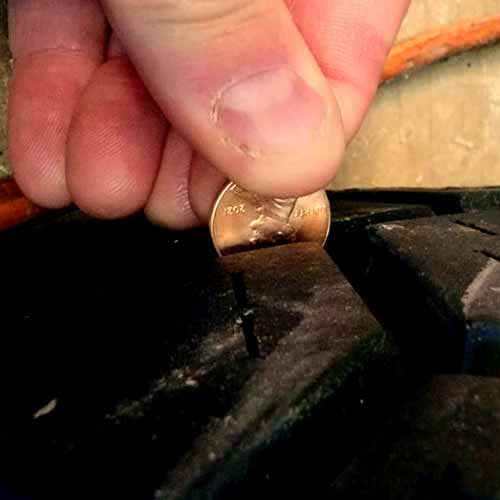Checking tire tread depth is an easy way to ensure your tires are safe and have enough tread to provide proper traction. And speaking of easy, one of the fastest way to check it is through your penny.

Although its not the most sophisticated way to check your tire’s tread depth (as that would be through the gauge), it still gets the job done.
Table of Contents
Follow these steps with your penny:
- Take a penny and turn it so that Lincoln’s head is facing down.
- Insert the penny into the tire tread.
- See if the Lincoln’s head is visible or not. If it is, then that means your tire has less than 2/32″ of tread depth left.
- If the top of Lincoln’s head is not visible, but the hairline of his head is visible, your tire tread depth is between 2/32 and 4/32 of an inch.
Replace your tires as soon as possible if it’s less than 2/32″, if it’s in between 2 and 4/32″, consider replacing your tires any time soon.
Important note: When measuring the tread with your penny, make sure you check at 3 different places on each tire, the central area of the tread and on each shoulders, this will help you in knowing whether your tires are wearing off evenly on not. If they are not that that’s the sign of either misalignment, or not having the same air pressure in all tires.
Keep in mind
When it comes to tire tread depth, it’s important to keep in mind that the standard of 2/32 inches is considered to be on the conservative side.
In fact, other industry experts recommend adhering to the 4/32 tire tread percentage rule for maximum safety and performance.
Waiting for the tread depth to reach the minimum of 2/32 inches can be risky, particularly when driving conditions are wet or slippery.
Additionally, it’s worth noting that according to a commonly used tire wear indicator chart in the United States, the legal limit for tread depth is 1.66 mm which is close to 2/32 inches, but the equivalent value of 2/32 inches in millimeters is slightly less.
Penny test is for tread depth, not wear
While doing the penny test, do keep in mind, that your tire may be going through some different kind of wear patterns (mentioned here). And so to check that, measure the tread depth at various locations, as I’ve already mentioned above.
For example if you have been running your tires with slightly higher pressure, the central part of the tread would wear off quickly compared to shoulders. And if the pressure was not ample, the shoulders wear faster.
Moreover, also make sure that penny test only measures tread depth, and it can not tell you the overall condition of the tire, where some tread wear factors include sidewall bulging, cuts, chips, damage to the bead area and so on. So while doing the test, make sure you analyze the tire’s tread as well by closely monitoring.
Quarter Test
If you have a quarter instead of penny, you can also make it work. In this case, you simply place a quarter into the tread and this time, with George Washington’s head facing down.
And if his head is not visible while doing so, then that would mean the tread depth is more than 4/32″, which means you can use your tires for a little bit more time.
Are These Tests Accurate?
Overall penny test is just a quick test which gives you a rough idea of tread depth. So its wise if you invest in a gauge. There are a lot of cheap options available, and they come in both digital and analog displays, measuring tires tread depth in multiple units as well including millimeters and inches.
Also note that some tires have tread wear indicators preinstalled in the tread. These are basically raised bumps located in the tread grooves. And when the tire’s tread is worn down to the level/height of these indicators, it’s time to replace the tire. (Continental tires are famous with them, FYI).
Note: Although all these tests including measuring with gauge can tell you a lot about the wear of your tires, they are still not a substitute for regular maintenance and inspections by a professional. So make sure you rotate your tires after every 5k miles, if you have on-road tires, and 3 to 4K miles, if you have all-terrain tires. Also you should get your tires aligned after every 6 months and of course there’s balancing as well, (which is though always included in tire’s rotation).
All these things improve your tire’s tread life.
Conclusion
It does not matter whether it’s the Lincoln’s head or George’s. These test only give you a rough idea in determining tire tread depth.
Though if you must, just know that if you insert both of these coins down and their heads are not visible, that in case of penny, that would mean, the tread depth is less than 2/32″. And in case of quarter, it would mean, the tread depth is more than 4/32″.
So you can get a rough estimate, if you are in a hurry by using both of these as 2/32″ means replacing your tires right away, where 4/32″ means, that you should be replacing tires in the coming time.
Though compared to both, its much better if you consider getting a tread measuring gauge.